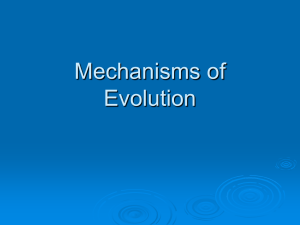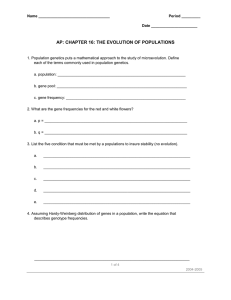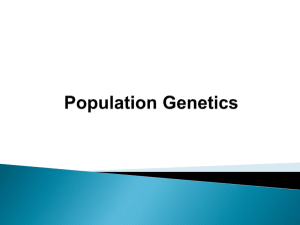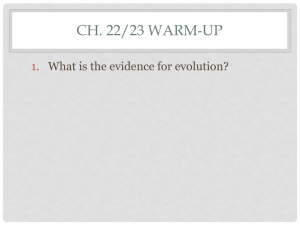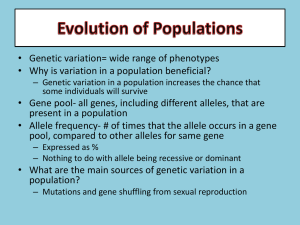Ch 16- Evolution of Populations
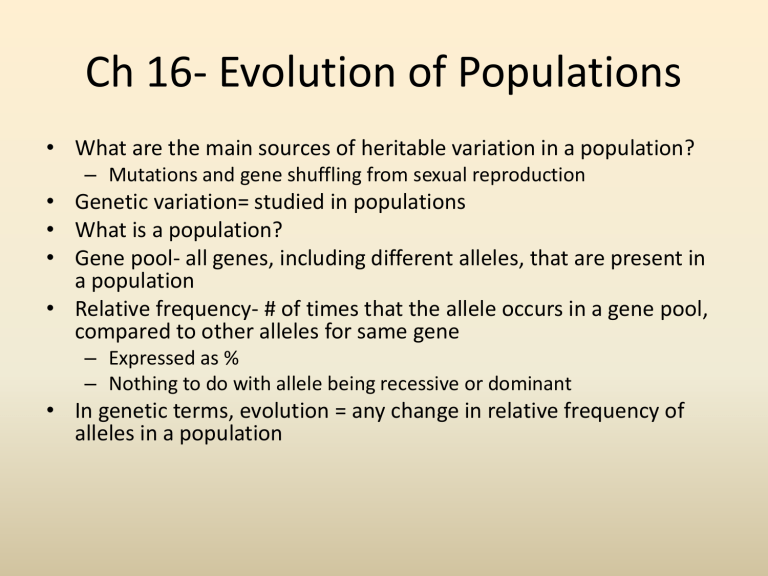
Ch 16- Evolution of Populations
• What are the main sources of heritable variation in a population?
– Mutations and gene shuffling from sexual reproduction
• Genetic variation= studied in populations
• What is a population?
• Gene pool- all genes, including different alleles, that are present in a population
• Relative frequency- # of times that the allele occurs in a gene pool, compared to other alleles for same gene
– Expressed as %
– Nothing to do with allele being recessive or dominant
• In genetic terms, evolution = any change in relative frequency of alleles in a population
Sources of Genetic Variation
• Main sources of genetic variation= mutations and genetic shuffling from sexual reproduction
• Mutations- any change in sequence of DNA
– May affect organism’s fitness or ability to survive and reproduce
– May have no effect on fitness
• Gene shuffling- occurs during production of gametes
– Crossing over
– Sexual reproduction- major source of variation within many populations
Single-Gene and Polygenic Traits
• What determines the numbers of phenotypes for a given trait?
– Depends on how many genes control that trait
• Single-gene trait- controlled by single gene that has two alleles
– Widow’s peak
• Polygenic trait- controlled by two or more genes
– Two or more alleles
– Many possible phenotypes and genotypes
Sec 2- Evolution as Genetic Change
• Evolution- any change over time in the relative frequencies of alleles in a population
– Populations evolve over time, not individuals
• How does natural selection affect single-gene and polygenic traits?
– On single-gene traits= can lead to changes in allele frequencies
• Organism of one color may produce fewer offspring than organisms of other colors
Natural Selection on Polygenic Traits
• Natural selection can affect the distributions of phenotypes by directional selection, stabilizing selection, disruptive selection
• Directional selection- individuals at one end of curve have higher fitness than individuals in the middle or at end
• Stabilizing selection- takes place when individuals near the center of curve have higher fitness than individuals at either end
• Disruptive selection- individuals at the upper and lower ends of the curve have higher fitness than individuals near middle
Genetic Drift
• Natural selection- not only source of evolutionary change
• Genetic drift- random change in allele frequencies that happens in small populations
– Individual with particular allele may leave more descendants than others, just by chance
– Over time, series of chance occurrences of this type can cause allele to become common in population
– May occur when small group of ind colonizes a new habitat
• Founder effect- allele frequencies change as a result of migration of a small subgroup of a pop.
Evolution Versus Genetic Equilibrium
• Hardy-Weinberg principle- allele frequencies in a pop will remain constant unless one or more factors cause those frequencies to change
• Genetic equilibrium- allele frequencies remain constant
• Conditions required to maintain genetic equilibrium
– Random mating
– Population must be large
– No movement into or out of population
– No mutations
– No natural selection
Sec 3- Process of Speciation
• Speciation- formation of new species
• What must happen for a species to evolve into two new species?
– Gene pools of two populations must become separated
• Reproductive isolation- members of two pop cannot interbreed and produce fertile offspring
– Behavioral isolation
– Geographic isolation
– Temporal isolation
• Behavioral isolation- two populations have differences in courtship rituals or other reproductive strategies that involve behavior
– Eastern and western meadowlarks
• Geographic isolation- two pops are separated by geographic barriers, like rivers, mountains, bodies of water
– Abert and Kaibab squirrel
– Do not guarantee formation of new species
– May separate some organisms but not others
• Temporal isolation- two or more species reproduce at different times
– Orchids in rain forest
• Welcome to Discovery Education Player
Speciation in Darwin’s Finches
• How did the process of speciation in the
Galapagos finches occur?
– Founding of a new population
– Geographic isolation
– Changes in new population’s gene pool
– Reproductive isolation
– Ecological competition
• Why is understanding evolution important?
– Drug resistance in bacteria and viruses
– Pesticide resistance in insects
• Evolutionary theory helps us understand and respond to these changes in ways that improve human life



